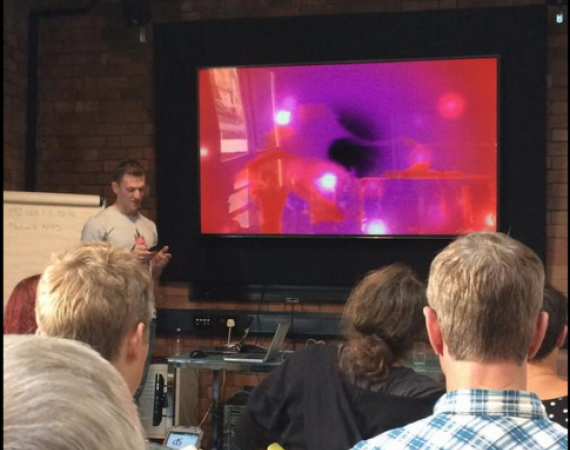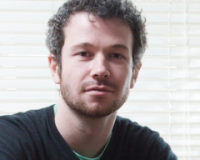Lunchtime talk write-up
Posted on Sat 5 Sep 2015
Evolving Atomic and Molecular Aesthetics
UWE lecturer and studio resident Tom Mitchell and creative technologies intern Ed Davies joined us to talk Interactive Evolutionary Computation (IEC).

Image thanks to Jon Aitken via twitter @jonbehere
Posted by
Speaker

Tom Mitchell
Tom Mitchell is a computer scientist, researcher and electronic musician lecturing computer music at the University of the West of England, Bristol.UWE lecturer and studio resident Tom Mitchell and creative technologies intern Ed Davies joined us today to talk Interactive Evolutionary Computation (IEC) and to put a glowing version of me as a real time energy field on our 83” screen.
Here are five things I learned:
1) No one really knows what atoms and molecuels look like
As atoms and molecules are too small to be seen, their visual representation involves a great deal of creative input. While these images are primarily designed to inform, they often have a certain aesthetic quality. A google image search for ‘electron density maps’ , for example, produces lots of different atomic and molecular imagery that should give you a sense of the range of aesthetic choices scientists have made.
In developing the interactice art and science quantum chemistry experience, danceroom Spectroscopy (dS), the team, in particular project lead David Glowacki and programmer and digital artist Phill Tew, have made lots of aesthetic decisions about how their atomic simulation should appear. The aesthetics and behaviour of dS are set by configuring hundreds of parameters. Creating a beautiful dS ‘state’ is highly skilled work as it requires knowledge of physics and computer graphics and most configurations are not particularly pleasing to audiences. The team would love to enable non-specialists or even members of the public to take control of these parameters. And so, Ed and Tom have been working on a cunning plan involving interactive evolutionary computation…
2) Box Car 2D is very cool
Box Car 2D is an online web application that uses evolutionary computation to create car designs, combining the attributes of those cars that perform the best and discarding those that perform the worst. Set it running now and see where it has got to by the time you finish reading this write up. This evolutionary approach inspired the team’s new ideas for designing the states of dS.
3) It is hard to automate the process of saying “that looks good”
Unlike Box Car 2D, finding an aesthetically pleasing dS states is not something that can be easily programmed or automated. It is highly subjective and depends on a range of conditions that may be personal, cultural and historically motivated.
4) Evolution requires a certain randomness
Subjective preferences often play an important role in the evolutionary process to ensure that favourable characteristics are able to survive and spread. Drawing on Richard Dawkins’ Biomorphs, the team have created an interactive, evolutionary interface for dS that allows people or even groups to express opinions about randomly generated dS states. Depending on the preferences expressed, new states are created that retain favourable characteristics, while mutations introduce novel aesthetic elements for further consideration. This process of aesthetic optimisation enables people interacting with dS to ‘breed’ their ideal aesthetic configurations.
5) There’s nothing quite like getting hands on
Tom and Ed set dS running for us to see, and with the Kinect camera pointed squarely in my direction, the lunchtime talk audience were able to make collective decisions about how I looked in dS, working towards an aesthetic we could all agree on – pretty much red and glowing won the day! They also introduced their very latest experiments that they have been developing with another Studio resident, Pete Bennett.
They have created circular tangible objects reminiscent of Petri dishes that are randomly assigned a set of parameters, which represent the genetic code of the object. Each Petri dish represents a different dS state and if there’s something that you like about one you can shake it to mutate it slightly, tap it together with another that you like to ‘breed’ them, or, if you don’t like it, tip it over to tip the genetic material away and start anew. This opens up great possibilities for installing dS in public and gallery spaces and allowing all kinds of new people to take the process of evolution into their own hands.
